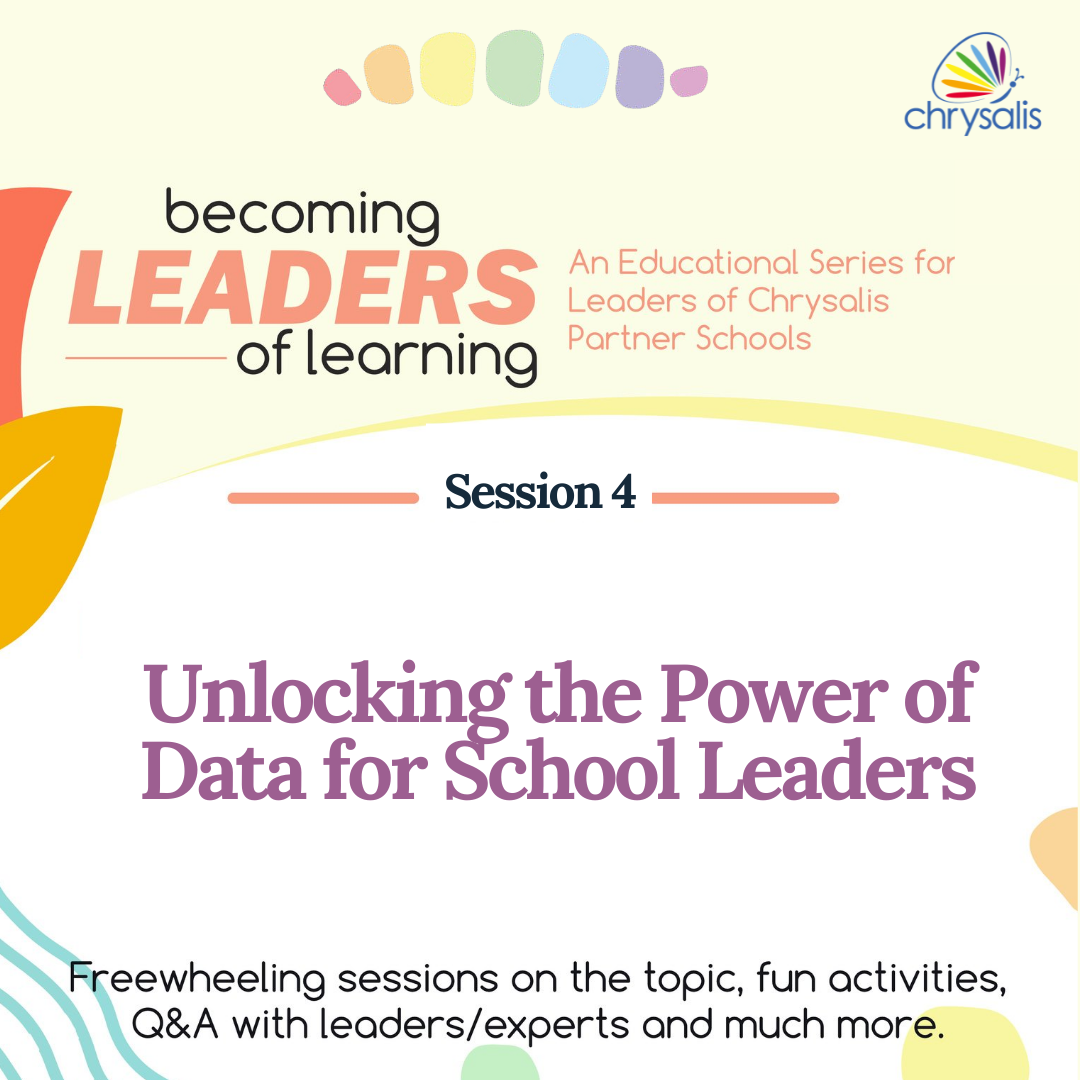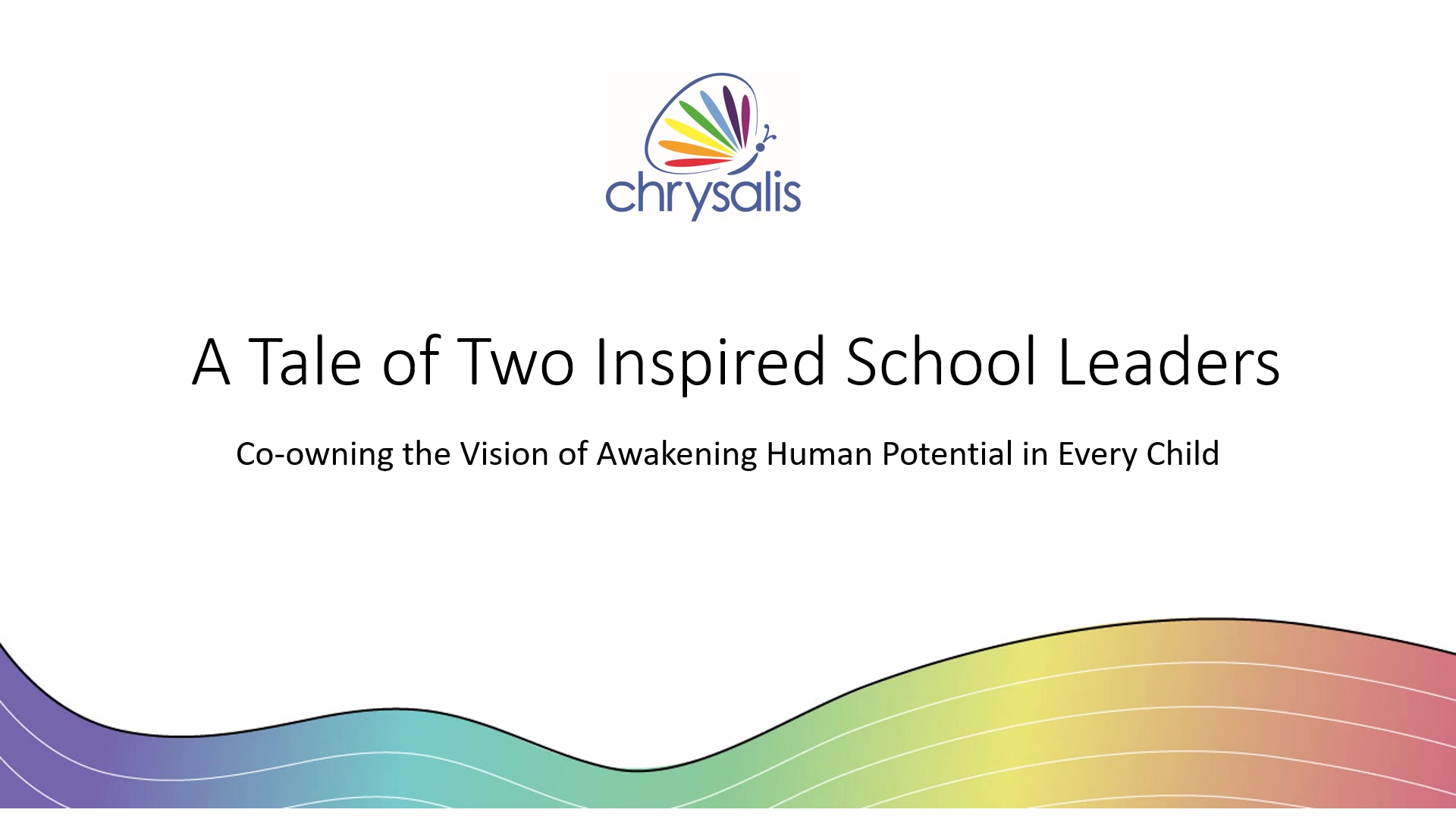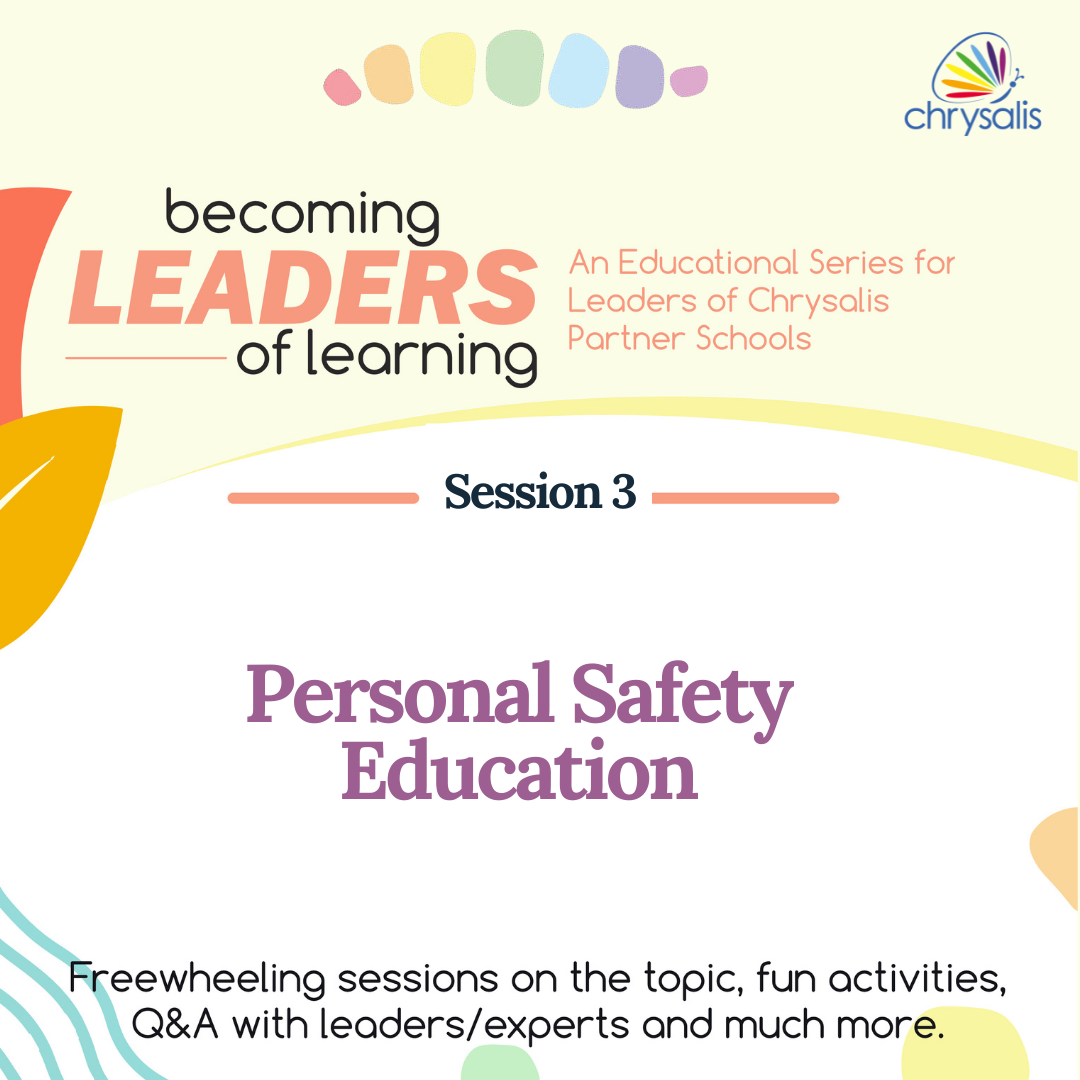Before we get into part 5 of this series, let’s have a quick recap of the previous parts. Session 1 was about professional development for teachers and a leaders’ role in that. Session 2 was about how to engage with parents and build a community that is based on trust. Session 3 was about personal safety education and picking relevant topics. Session 4 is about unlocking the power of data for school leaders. Session 5 is about problem-solving techniques. Problem-solving is a 4-step process:
- Define
- Investigate
- Brainstorm
- Make the decision

1. Defining the problem statement
Ask the question "What is the situation/behavior we are observing?". Articulate the problem as a statement. It is difficult but this will help you solve most of the problems. Choose the challenge to focus on, prioritize it based on factors like time, importance, etc.
Fact vs Opinion
We have the amygdala, "the emotional hot seat" of the brain which leads us to take wrong decisions. So, we should take the emotions out of this process and look at the facts. Fact vs opinion is the first step in overcoming the problem. Consider 2 statements:
- Admissions are low!
- Admissions have steadily been reducing by 10% over the last three academic years in kindergarten.
The first one is a global statement. All the negative emotions like "Is it my fault?", "Is it my team's fault?", "Maybe I'm not good enough for this job." arise from this. The second statement leads to better diagnosis because it's clear, fact-based, and verifiable. The first statement is opinionated but the second statement is a fact. It is very important to have the discernment between fact and opinion.
Fact or Opinion – How to decide?
Factual statements can be to be proven true or false. Opinionated statements can be argued against/supported with facts. The first step in problem-solving is making the problem statement as factual as possible and don’t start it as an opinionated statement.
Some examples of opinionated statements are:
Parents want more homework, Online training sessions are ineffective, There are very few practice questions in Math, Only bright students can answer such questions
Some examples of factual statements are:
Available teaching time has come down by 50%. Student performance in exams has declined in the last year. 20% of students in each grade are able to demonstrate previous grade’s learning outcomes in English and Maths.
Let’s look at the words used in the examples above:
Ineffective - How do you say it's ineffective?
Very few - Few in relation to what? How do you quantify it?
Bright students - What do you mean by bright students?
2. Investigating the problem
An investigation is finding out the root cause of the stated problem. Let’s take the previous problem statement, “Admissions have dropped 10% in the KG section.” Let’s say that the inquiries about your school are high but their conversion to actual admissions is low. The investigation can be in the direction of asking questions like “What is happening between people coming to our school and getting them to apply?”, “Should I check on the orientation by the receptionist or the admissions counselor?”, “Is the fee structure planned ‘appropriate’ for my demography?”, “Is the value proposition evident to the parents?” We have to pull out the relevant data and study them to gather insights. Then, we can create a strategy to solve the problem.
Fishbone Strategy
Problem: 75% of the parents of 3rd and 4th graders have stated that they expect everyday homework in English and math.
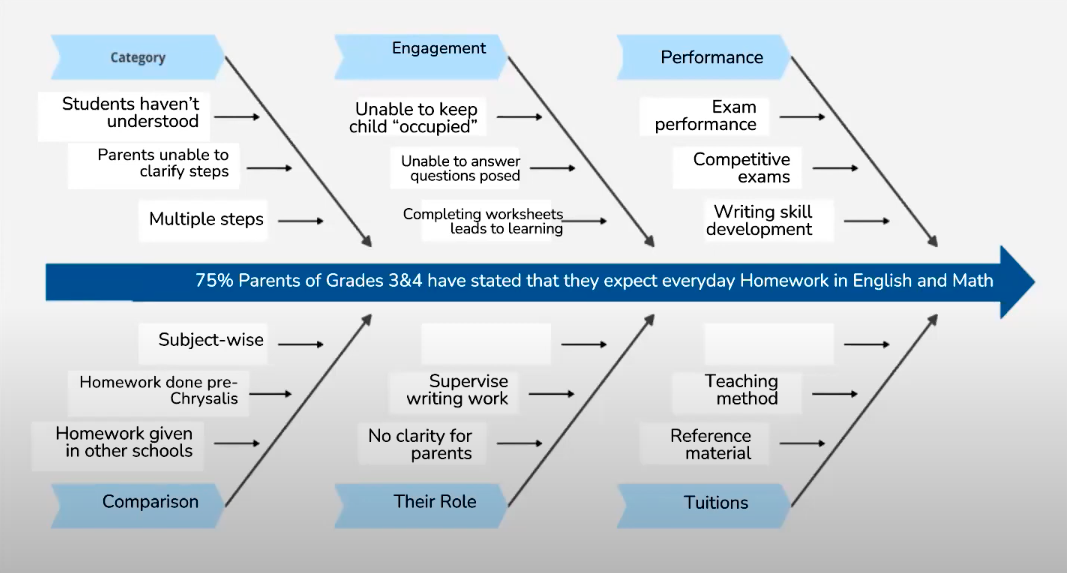
Since it looks like a fishbone, it's called a fishbone strategy. We have to note the factors that lead to this problem. These factors can even have sub-factors. In this problem, the factors can be many reasons like “Parents want to keep their children occupied.”, “Performance like writing skill development is not great.”, “Comparing the homework grade-wise or subject-wise." Fishbone strategy is analyzing the root causes to see which ones have evidence. A doctor doesn’t prescribe medicines because patients want them. He or she examines the patients and diagnoses the disease before treating them. Similarly, we can’t solve problems based on wants and wishes. We have to pick the root causes that have an effect on the problem and solve them.
3. Brainstorm
We usually associate it with chaos and people writing down or voicing their ideas. But we do it because we want to get as many ideas as possible to find a viable solution. The idea of brainstorming is for people to share their thoughts and ideas get many different perspectives. As a school leader, you don’t have to find solutions by yourself. You can involve your team of teachers and academic coordinators who would love to give their two cents. Another important aspect of brainstorming is to accept all ideas without judgment. Then, we can select the ideas that are feasible and build a strategy around them. We have protocols for discussions and addressing challenges which we discussed in session 1 of Becoming Leaders of Learning series. You can check it out here. Similarly, there is a flow for solving problems too. We take a challenge, convert it into problem statements based on facts, present them to teachers who in turn can give different ideas that can be implemented to solve the problem statements.
Ideas for Brainstorming and Strategizing
Slipwriting – This is a simple idea where each person anonymously writes one idea and after reading out all the ideas, the ideas are voted. The idea with the most votes can be considered and implemented.
Carousel or rotation review – This is a moderately complex concept that can be used when addressing multiple problems or multiple elements of a problem. People are divided into different groups and they write their solutions to the problem statements specified on a poster paper. They can also vote on the existing solutions or write their own solutions.
Bono’s 6 thinking hats – It is a highly complex idea where each person wears a different colored hat (physical or metaphorical) and plays a unique role to help view each solution through a different lens. The idea is to get different perspectives on the problem and see them from different angles. Here’s the visual representation of the six thinking hats.

4. Decision Making
Let’s consider this decision for the example in the fishbone strategy: Give more homework across subjects for grades 3 and 4. List out the pros and cons of this decision. The pros are parents are happy, increased performance by the student. One con is that the teachers’ workload will increase. Each decision we take will have multiple side effects. So, plan the risk (cons) mitigation for different stakeholders (in this case, teachers, students, parents). Then, assign roles and responsibilities to ensure effective implementation of the strategy. Tell the parents that since they are just simple practice homework, students can exchange the notebook and correct them, instead of teachers doing it. Last, but not least, communicate your strategy to all the stakeholders. Inform the teachers and the parents that there's gonna be more homework and that kids are gonna correct it themselves beforehand. This will save the trouble of parents saying that teachers are not correcting the kid's homework. And the teachers needn't dread the extra workload.
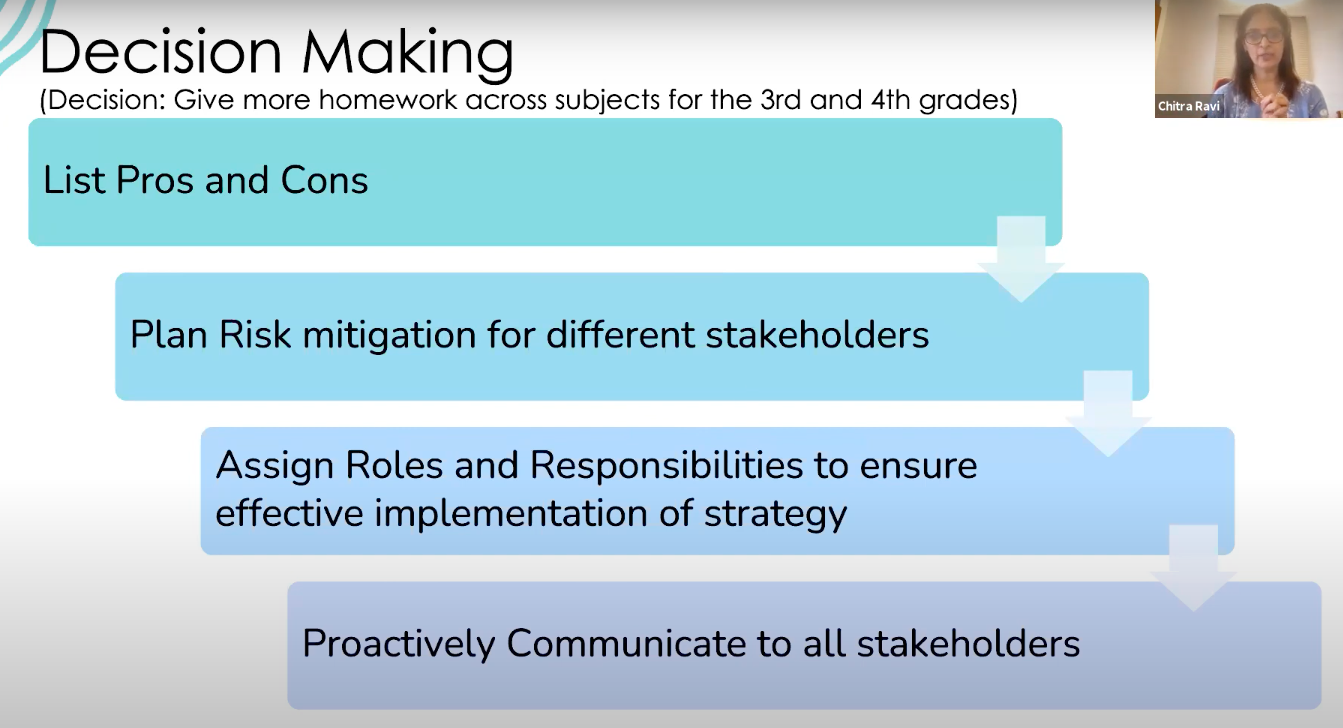
After these 4 steps, there are 2 more steps in the problem-solving cycle. The first one is to implement the plan and periodically track its efficiency and reflect on the progress and learning. This includes asking questions like "Are we headed in the desired direction?", "Are there any major side-effects of the solution that are cropping up?". The last step is reflecting on the progress and learning. Ask yourself, "Did I make a good decision?" "Have I involved the community?" "Can I do better?". Reflection is an important step in your evolution as a leader.
To summarize this webinar, we talked about the 4 + 2 Step process for problem-solving. They are,
- Defining the problem clearly based on facts
- Investigating the root cause of the problem using strategies like the fishbone strategy
- Brainstorming for solutions using methods like slipwriting, carousel review, and Bono's 6 thinking hats
- Decision making with consideration to various risk factors
- Implementing the decision and tracking its efficacy
- Reflecting on the progress and learning from past mistakes
The most important part of the problem-solving process is teamwork. Involve your people in the entire process. Decentralize the decision-making process. Share your wins with the community and inspire others. Chrysalis spotlight is a great way to share your success stories and check it out here.
You can watch the recording of the webinar below.




